Explore Bayan-Ölgii - Mongolia Travel, Asia
Nestled in the remote western corner of Mongolia, Bayan-Ölgii is a land where rugged landscapes meet rich cultural traditions. This province, bordered by Russia to the north and China to the west, is a unique destination that offers travelers a glimpse into the life of the Kazakh people, who have called this region home for centuries. From the snow-capped peaks of the Altai Mountains to the vibrant festivals that celebrate the Kazakh heritage, Bayan-Ölgii is a destination that promises both excitement and discovery.
Population: Approximately 100,000 in 2020.
Economy: Bayan-Ölgii’s economy is driven by agriculture, animal husbandry, and tourism. Key sectors include livestock farming and traditional crafts, with growing interest in eco-tourism and cultural experiences.
Landmarks: Famous for the Altai Tavan Bogd National Park, Sagsai Eagle Hunter Village, and Khoton and Khurgan Lakes.
Mongolia
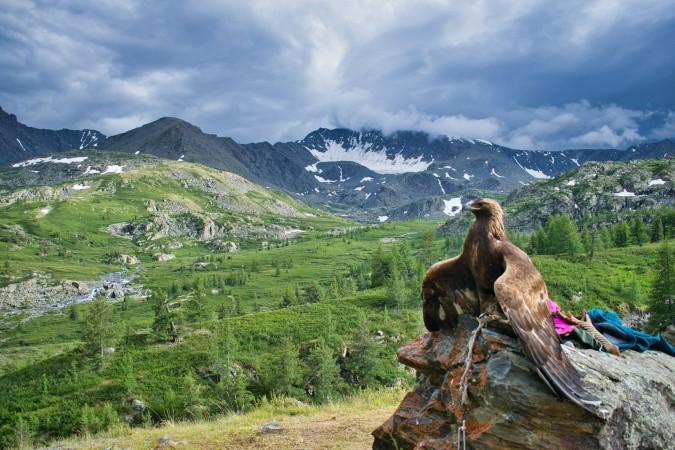
Overview of Bayan-Ölgii
History & Cultural Influence
Bayan-Ölgii is more than just a picturesque destination; it’s a region steeped in history and cultural significance. The province’s history is deeply intertwined with the Kazakh people, who migrated to Mongolia in the 19th and early 20th centuries. The migration has left a lasting effect on the region, making Bayan-Ölgii the center of Kazakh culture in Mongolia. The culture here is rich and dynamic, with the Islamic faith guiding everyday routines and traditional art forms passed down through generations.
Interaction with The Locals
The Kazakh community in Bayan-Ölgii has preserved its distinct cultural identity, language, and traditions, making it a unique part of Mongolia. The citizens of Bayan-Ölgii are known for their strong sense of hospitality, welcoming visitors with warmth and an eagerness to share their rich heritage. Alongside the Kazakhs, there are smaller populations of Tuvans and Uriankhai, each contributing to the region’s diverse cultural tapestry.
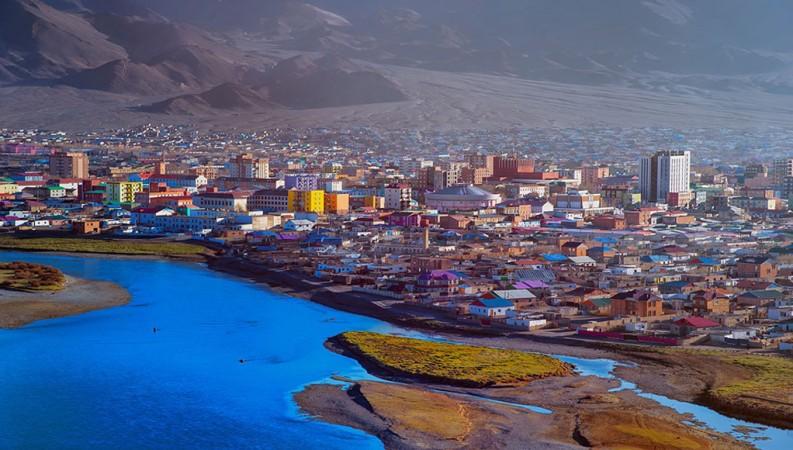
Bayan-Ölgii - © Bayan-Ölgii Official
Top Attractions in Bayan-Ölgii
Bayan-Ölgii is a treasure trove of natural and cultural attractions, each offering a unique glimpse into the beauty and heritage of this remote region. Whether you’re an adventure seeker or a history buff, there’s something for everyone in Bayan-Ölgii.
Altai Tavan Bogd National Park
The crown jewel of Bayan-Ölgii, Altai Tavan Bogd National Park, is a must-visit for any traveler. The park is home to Mongolia’s highest peaks, including Khüiten Peak, which towers at 4,374 meters. Visitors can trek through stunning valleys, explore ancient petroglyphs, and camp beside pristine lakes. The park also offers opportunities for glacier climbing, horse riding, and bird watching.
Khoton and Khurgan Lakes
These twin lakes, located near the Chinese border, are renowned for their crystal-clear waters and breathtaking surroundings. The lakes are a haven for wildlife and offer excellent fishing and photography opportunities. Surrounded by snow-capped mountains and lush meadows, Khoton and Khurgan Lakes are perfect for those seeking tranquility and natural beauty.
Sagsai Eagle Hunter Village
A visit to Sagsai Village provides a unique opportunity to meet the legendary Kazakh eagle hunters. These hunters, who have been practicing this ancient art for generations, are more than willing to share their knowledge and demonstrate their skills. Visiting during the Golden Eagle Festival, held annually in October, allows you to witness these majestic birds in action as they soar above the Altai Mountains.
Tsambagarav National Park
This lesser-known national park is home to the Tsambagarav Mountain, one of Mongolia’s sacred peaks. The park offers a range of outdoor activities, including trekking, mountaineering, and wildlife spotting. Tsambagarav is especially known for its glaciers and the diverse wildlife that inhabits the area, such as ibex and snow leopards. The surrounding valleys are dotted with traditional Kazakh villages, where visitors can experience local life and hospitality.
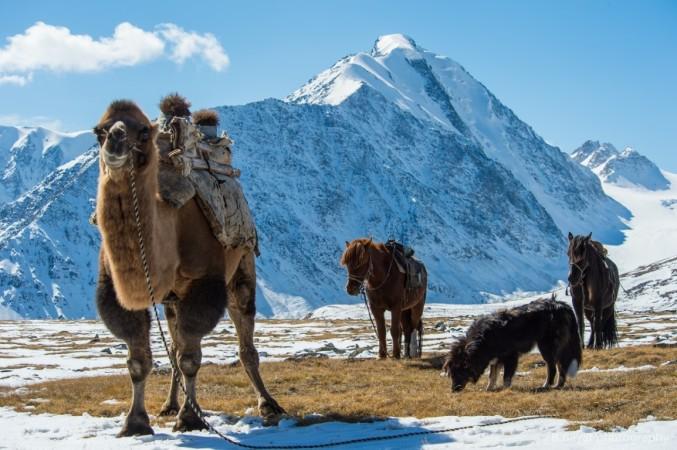
Altai Tavan Bogd National Park - © Mongolia Tourism
Must-Try Dishes in Bayan-Ölgii
Bayan-Ölgii offers a culinary experience deeply rooted in Kazakh traditions, with a touch of Mongolian influence. The region’s cuisine is hearty, flavorful, and reflective of the nomadic lifestyle.
- Beshbarmak: This delicacy, which means "five fingers" in Kazakh, is the region's best-known dish. It consists of boiled meat, typically mutton or beef, served on a bed of wide noodles, and garnished with onions and a rich broth.
- Kazy: Kazy is a traditional sausage made from horse meat, a delicacy highly prized in Kazakh culture. The sausage is typically served as an appetizer, sliced thin and enjoyed with bread.
- Baursak: Baursak are small, deep-fried dough balls, similar to donuts, that are often served during festivals and special occasions. They are slightly sweet and are usually enjoyed with tea or as a dessert.
- Kumis: Kumis, a fermented mare's milk, is the national drink of Kazakhstan and a popular beverage in Bayan-Ölgii. It has a slightly sour and tangy taste, with a mild alcoholic content. Drinking kumis is a traditional practice that offers a taste of the nomadic lifestyle.
- Shalgam: Shalgam is a Kazakh-style stew made from turnips, potatoes, carrots, and chunks of meat, typically mutton or beef. It is frequently served with a side of bread and a dab of sour cream.
- Karta: Karta is a dish made from boiled and smoked horse intestine, a delicacy in Kazakh cuisine. It’s typically served as an appetizer or a side dish and is often accompanied by slices of horse sausage, such as kazy.
- Sorpa: Sorpa is a traditional Kazakh soup made from mutton or beef, flavored with root vegetables, and seasoned with black pepper and herbs. It’s a nourishing dish, often served as a starter before the main course.

Beshbarmak - © Friends of Kyrgyzstan
Festivals & Local Celebrations
Bayan-Ölgii is a region rich in cultural heritage, and its festivals and local celebrations are a testament to the vibrant traditions of the Kazakh people. Attending one of these events provides a unique opportunity to learn about local culture firsthand.
Golden Eagle Festival
The Golden Eagle Festival is the most popular festival in Bayan-Ölgii, drawing guests from all over the world. Held annually in October, this festival celebrates the ancient art of eagle hunting, a tradition that has been passed down through generations. Eagle hunters dressed in traditional garb participate in a series of competitions to show off their trained eagles' talents. The festival also features traditional music, dance, and games, providing a deep insight into Kazakh culture.
Nauryz Festival
Nauryz, the Kazakh New Year, is celebrated on March 21st and marks the arrival of spring. The festival is a time of renewal and is characterized by communal feasts, traditional music, and various cultural performances. Families prepare special dishes, such as Nauryz kozhe (a festive soup), and gather to celebrate with their neighbors. Visiting Bayan-Ölgii during Nauryz offers a joyful and immersive cultural experience.
Altai Kazakh Folk Festival
This festival, held in the summer, celebrates the rich folk traditions of the Kazakh people in Bayan-Ölgii. The event features traditional music, dance, and performances by local artists. Visitors can enjoy folk songs accompanied by the dombra, a traditional string instrument, and witness the vibrant dance forms that have been preserved through generations.

Golden Eagle Festival - © Mongolia Tourism
What to Do in Bayan-Ölgii
Bayan-Ölgii is a paradise for adventure seekers and cultural enthusiasts. The region’s diverse landscapes and rich heritage provide a wide range of activities for travelers.
- Trekking in Bayan-Ölgii: Bayan-Ölgii is home to some of Mongolia’s most challenging and rewarding trekking routes. The Altai Tavan Bogd National Park offers opportunities for multi-day treks, where travelers can explore rugged mountains, glaciers, and pristine lakes. The ascent of Khüiten Peak, Mongolia’s highest mountain, is a highlight for experienced climbers.
- Eagle Hunting Expeditions: For those interested in the ancient art of eagle hunting, Bayan-Ölgii offers guided expeditions with local eagle hunters. These excursions allow visitors to accompany hunters as they train and hunt with their eagles, providing an authentic and hands-on cultural experience.
- Horseback Riding: Horseback riding is an integral part of the nomadic lifestyle in Bayan-Ölgii. Visitors can embark on horseback journeys through the region’s stunning landscapes, guided by experienced Kazakh horsemen.
- Cultural Tours: Cultural tours in Bayan-Ölgii offer visitors the chance to explore traditional Kazakh villages, visit local artisans, and participate in cultural activities, providing a deeper understanding of the local way of life and the cultural heritage that defines Bayan-Ölgii.
Shopping in Bayan-Ölgii
Shopping in Bayan-Ölgii is a cultural experience in itself, offering visitors the opportunity to bring home unique, handcrafted items that reflect the region's rich Kazakh heritage.
- Ölgii Central Market: The Ölgii Central Market is the heart of commerce in the provincial capital. Here, you can find handmade felt products, such as rugs, slippers, and hats, all crafted using techniques passed down through generations.
- Kazakh Embroidery Shops: Kazakh embroidery is renowned for its intricate designs and vibrant colors, often used to adorn clothing, yurts, and household items. Whether you're looking for a wall hanging, pillow cover, or traditional garment, these shops offer a range of items that make for meaningful souvenirs or gifts.
- Felt Craft Workshops: These workshops often sell a variety of felt products, from decorative rugs to practical items like bags and coasters. Purchasing directly from these workshops not only supports local artisans but also gives you the chance to learn about the traditional felt-making process.
- Eagle Hunting Accessories Stores: For those intrigued by the ancient tradition of eagle hunting, Bayan-Ölgii offers a selection of handcrafted accessories used by eagle hunters. Items such as leather gloves, hoods, and harnesses are available in specialty shops. These unique items not only serve as cultural souvenirs but also tell the story of the region’s deep connection with this age-old practice.
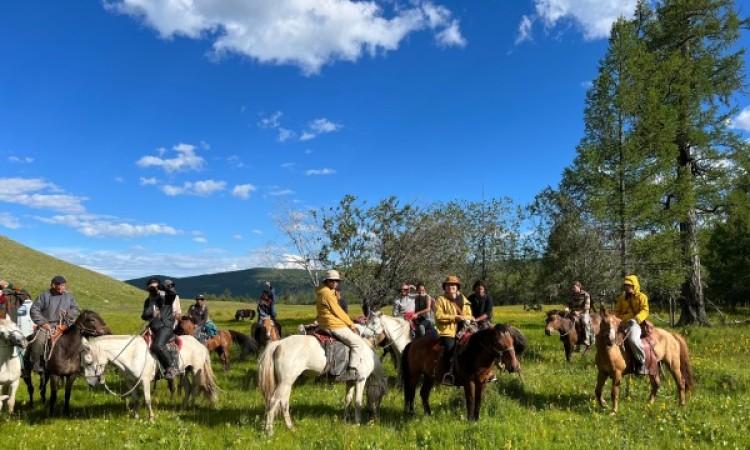
Horseback Riding in Bayan-Ölgii - © VnExpress
Weather in Bayan-Ölgii: Best Time to Visit
Spring in Bayan-Ölgii
Spring brings a gradual thaw to Bayan-Ölgii, with temperatures slowly rising and the landscape beginning to bloom. However, it can still be chilly, especially in the early mornings and evenings, with temperatures ranging from -5°C (23°F) to 10°C (50°F). Spring is a quieter time for tourism, offering a peaceful experience as the region awakens from its winter slumber.
Summer in Bayan-Ölgii
Summer is the most popular season for tourists visiting Bayan-Ölgii, as the weather is relatively mild and pleasant. Daytime temperatures typically range from 15°C (59°F) to 25°C (77°F), making it ideal for outdoor activities such as hiking, horseback riding, and exploring the stunning Altai Mountains. However, summer nights can still be cool, so packing layers is recommended.
Autumn in Bayan-Ölgii
Autumn is a short but beautiful season in Bayan-Ölgii. The region’s landscapes are painted in vibrant shades of red, orange, and gold as the foliage changes. Temperatures begin to drop, ranging from 5°C (41°F) to 15°C (59°F), and the first frosts can arrive as early as late September. Autumn is also a popular time for the Golden Eagle Festival, one of the region's most celebrated events.
Winter in Bayan-Ölgii
Winter in Bayan-Ölgii is long, bitterly cold, and often accompanied by heavy snowfall. Temperatures can plunge well below freezing, sometimes reaching as low as -30°C (-22°F). The scenery transforms into a winter wonderland, making it a great time for people who like winter activities such as ice fishing and skiing. However, proper winter gear is essential to withstand the extreme cold.
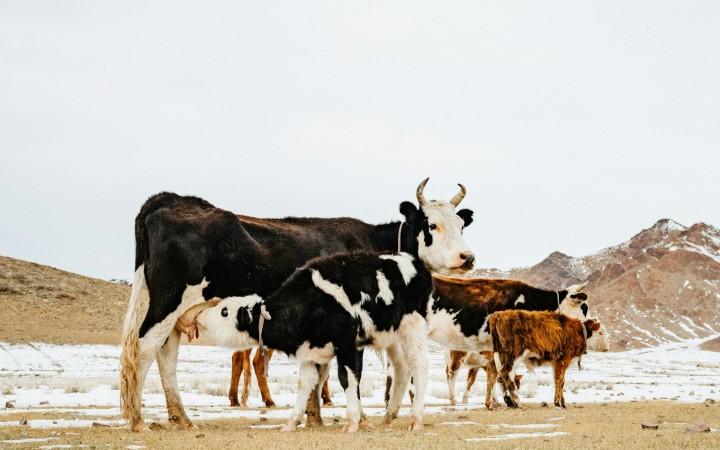
Winter in Bayan-Ölgii - © Fadhil Abhimantra
Essential Travel Information
Navigating Bayan-Ölgii
Getting to Bayan-Ölgii
- By Air: Ölgii Airport offers regular flights to and from Ulaanbaatar, the capital of Mongolia. The flight takes approximately 3 hours, and during the summer months, additional flights may be available to accommodate the influx of tourists.
- By Road: For those seeking adventure, traveling by road is an option, though it’s a lengthy and challenging journey. The road from Ulaanbaatar to Bayan-Ölgii spans over 1,600 kilometers and takes approximately 2 to 3 days by car, depending on road conditions.
Getting Around Bayan-Ölgii
- Local Transport: Once in Bayan-Ölgii, getting around the town of Ölgii is relatively straightforward. Taxis are available and can be hired for short trips or full-day excursions. For more remote areas, hiring a local driver with a 4x4 vehicle is recommended, especially if you plan to explore the Altai Mountains or visit nomadic communities.
- Horseback Riding: For a truly authentic experience when you set foot on this land, consider traveling by horseback, as many locals do. Horses are an integral part of life in Bayan-Ölgii, and riding is a popular way to explore the rugged terrain.
ATM & Banking Services
Accessing cash and banking services in Bayan-Ölgii requires careful planning due to its remote location and limited financial services. ATMs are available in the town of Ölgii, though they can be unreliable and may run out of cash, so it's wise to withdraw funds upon arrival and carry Mongolian Tugrik (MNT) as a backup. Credit cards are accepted at some hotels, restaurants, and shops, but their use is uncommon in rural areas, so it's essential to have enough cash for your entire trip, especially if visiting remote communities or engaging in outdoor activities where card payments aren't possible.
Where to Stay in Bayan-Ölgii
- Hotels: These hotels in Ölgii offer basic amenities such as hot water, Wi-Fi, and sometimes even on-site restaurants. The hotels vary in price and comfort, with some providing more luxurious options with en-suite bathrooms and others offering simpler, budget-friendly rooms.
- Ger Camps: For those seeking to immerse themselves in the nomadic lifestyle, staying in a traditional ger (yurt) camp is an unforgettable experience. Ger camps are scattered throughout Bayan-Ölgii, particularly in scenic areas like the Altai Mountains. These camps offer a unique blend of rustic charm and comfort, with gers equipped with wood-burning stoves, comfortable bedding, and communal dining areas.
- Homestays: Homestays provide an opportunity to live with a local family and experience daily life in Bayan-Ölgii. This type of accommodation is ideal for travelers who want to connect with the local culture and enjoy home-cooked meals. Homestays are typically more affordable than hotels and offer a genuine, off-the-beaten-path experience.
Articles for you

Explore Yala National Park - Sri Lanka Travel, Asia
Tucked away in Sri Lanka’s southeastern corner, Yala National Park is where wild nature meets deep tradition. Known worldwide for its leopard population, the park is also home to elephants, sloth bears, crocodiles, and hundreds of bird species. Beyond wildlife, Yala opens doors to a cultural landscape dotted with ancient temples, Buddhist ruins, and coastal villages. For travelers seeking more than just a safari, Yala offers a chance to explore eco-tourism, local communities, and sacred heritage sites.
Population: The Yala National Park area doesn’t have a human population.
Economy: The economy around Yala National Park thrives on a blend of eco-tourism, agriculture, and local services. Safari tours, eco-lodges, and cultural experiences drive steady income for nearby towns like Tissamaharama and Kataragama, supporting thousands of families.
Landmarks: Famous for Block I of Yala and wildlife encounters, including elephants, sloth bears, crocodiles, and exotic bird species.

Explore Galle - Sri Lanka Travel, Asia
Nestled on Sri Lanka’s southern coastline, Galle is a vibrant city where history meets the sea. Its cobbled streets, colonial architecture, and serene beaches make it a must-visit destination for travelers seeking a blend of culture, adventure, and relaxation. A UNESCO World Heritage site, Galle captivates visitors with its Dutch Fort, bustling markets, and friendly locals. Whether you’re exploring the ramparts at sunset or savoring fresh seafood by the shore, Galle promises an unforgettable journey into Sri Lanka’s heritage.
Population: Approximately 113,000 in 2023.
Economy: Galle’s economy thrives on tourism, trade, and fisheries. The city’s historic fort, colonial architecture, and coastal charm draw thousands of international visitors each year, making tourism its main economic driver. Fishing remains vital for local livelihoods, supplying fresh seafood across the region.
Landmarks: Famous for the Galle Fort, Dutch Reformed Church & Maritime Museum, and Unawatuna Beach.

Explore Bentota - Sri Lanka Travel, Asia
Nestled along Sri Lanka’s southwestern coast, Bentota is a tropical paradise that blends golden beaches, vibrant culture, and thrilling adventures. Famous for its calm waters, luxury resorts, and scenic river estuary, Bentota has become a top destination for travelers seeking both relaxation and authentic experiences. From serene beach walks at sunrise to adrenaline-pumping water sports, this coastal town offers a perfect balance of leisure and exploration. With its proximity to Colombo and Galle, Bentota is easy to reach, making it an ideal stop for both short escapes and extended holidays.
Population: Approximately 37,000 in 2023.
Economy: Bentota’s economy thrives mainly on tourism, which drives local businesses such as hotels, restaurants, and wellness retreats. The town also benefits from fishing, coconut cultivation, and handicrafts like wood carving and batik textiles. Many residents rely on the growing demand for water sports and Ayurvedic treatments, making tourism the backbone of both income and employment in the area.
Landmarks: Famous for Bentota Beach, Bentota River Safari, and Kande Vihara Temple.

Explore Mirissa - Sri Lanka Travel, Asia
Mirissa is a charming coastal town on Sri Lanka’s southern shoreline. Known for its golden beaches, turquoise waters, and vibrant marine life, it has become a must-visit stop for travelers exploring the island. Many come for whale watching, surfing, and sunset views at Coconut Tree Hill, but Mirissa offers much more than postcard beauty. The fishing boats you see anchored by the bay carry generations of stories. Local traditions, delicious cuisine, and a laid-back rhythm of life shape every visitor’s experience.
Population: Approximately 4,700 in 2023.
Economy: Mirissa’s economy is largely shaped by its coastal location. Fishing has long been the backbone of local livelihoods, with generations relying on the Indian Ocean for income. In recent decades, tourism has become the main driver of growth, thanks to whale watching, surfing, and beachside hospitality.
Landmarks: Famous for Mirissa Beach, Coconut Tree Hill, and Parrot Rock Bridge.

Explore Nuwara Eliya - Sri Lanka Travel, Asia
Tucked away in the Central Highlands of Sri Lanka, Nuwara Eliya is often called “Little England”. With its rolling tea plantations, cool misty mornings, and colonial charm, this mountain town feels like a step into another world. Travelers come here to breathe fresh air, walk through flower gardens, sip the finest Ceylon Tea, and enjoy a pace of life far from the island’s busy cities. Whether you’re drawn by scenic landscapes, heritage architecture, or the warmth of its people, Nuwara Eliya is a destination that blends nature, culture, and history in perfect harmony.
Population: Approximately 781,000 in 2023.
Economy: Nuwara Eliya’s economy thrives mainly on tea production, as it sits in the heart of Sri Lanka’s central highlands, famous worldwide for Ceylon Tea. The city also benefits from a growing tourism industry, attracting visitors with its colonial charm, cool climate, and scenic landscapes.
Landmarks: Famous for Gregory Lake, Hakgala Botanical Garden, and Victoria Park.

Explore Sukau - Malaysia Travel, Asia
Nestled on the banks of the Kinabatangan River in Sabah, Malaysian Borneo, Sukau is a destination where wildlife, culture, and conservation come together. Known as one of Asia’s top spots for river safaris and eco-tourism, this quiet village offers a front-row seat to encounters with Bornean orangutans, pygmy elephants, proboscis monkeys, and exotic birdlife.
Population: Approximately 1,400 in 2019.
Economy: Sukau’s economy is shaped by its riverine location and natural resources. Traditionally, the Orang Sungai community relied on fishing, small-scale farming, and forest gathering for their livelihood. Today, the village has shifted toward eco-tourism, with river cruises, jungle trekking, and homestays providing income.
Landmarks: Famous for the Kinabatangan River cruises, Gomantong Caves, and Ox-bow lakes and wetlands.
